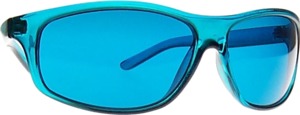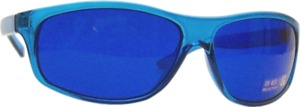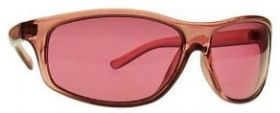































































Color Therapy Glasses
- $26.95 USD
- $26.95 USD
- Unit price
- per
 Expose your body to the color frequency needed to bring it back into a balanced state while going about your daily tasks. Simply wear the glasses for 10-30 minutes a day (up to 60 minutes), in the color which corresponds to the results you desire.
Expose your body to the color frequency needed to bring it back into a balanced state while going about your daily tasks. Simply wear the glasses for 10-30 minutes a day (up to 60 minutes), in the color which corresponds to the results you desire.
Emotions and moods can be affected by the use of color. Each color's vibration is associated with different attributes and qualities. One method of utilizing color to alter your mood or emotion is to wear color therapy glasses, looking at the world through "rose colored glasses", if you will (or green colored or yellow colored of violet colored, etc). The color of the light entering your body is concentrated in one spectrum. The mood or emotions associated with that color are enhanced, causing a shift in that direction.
Wear them inside or outside the house. Be careful - some of the dark colors may make things hard to see.
The sport style provide 95% UVB and 60% UVA protection, whereas the classic style provide no UV protection. Uni-colored plastic frames. Sport style Color Therapy Eyeglasses come with a rubber piece on the arms to help secure them on your head.
|
Aqua (Turquoise) Colored Glasses |
|
|
Magenta Colored Glasses |
|
|
Red Colored Glasses |
|
|
Orange Colored Glasses |
|
|
Yellow Colored Glasses |
|
|
Green Colored Glasses |
Click here to read how researchers are succesfully using the color green to deal with chronic pain such as migraine and headaches. |
|
Blue Colored Glasses |
|
|
Violet (Purple) Colored Glasses |
|
|
Indigo Colored Glasses Note: The sports model shown above is an Indigo Blue, whereas the classic model shown below is an Indigo Purple. Both models have the same therapeutic effect as described.
 |
|
|
Baker-Miller Pink Colored Glasses |
|

Rose Colored Glasses
(Note: Only available in the Classic style) |
|
Colors shown above include Blue, Green, Yellow, Orange, Red, Magenta, Aqua (turquoise), Indigo, Violet, . The complete set includes a 10th pair that is not shown in the image, namely the Baker Miller Pink Glasses.
 Warning
Warning
We do not recommend that you wear these glasses while driving, as they may change the color of traffic lights or brake lights. Darker colored objects may also be harder to see.
| Dimensions |
|
LENS: 64 mm X 40 mm (~2 1/2" X ~1 1/2" ); HINGE TO HINGE: 133 mm (~5 1/4" ) |
Baker-Miller Pink Color Therapy Glasses
In 1979, Alexander G. Schauss, Ph.D, experimented with the use of a particular shade of pink and its affect on mood and behavior. He called the color Baker-Miller Pink. It was found that this pink color was associated with a short-term decrease in aggression. Subsequent experiments also found that this shade of pink could also act as a natural appetite suppressant. His report follows below.
Baker-Miller Pink Color Therapy Study
This Article is a Summary of Dr. Alexander G. Schauss' Work as Reported In The Physiological Effect of Color on the Suppression of Human Aggression: Research on Baker-Miller Pink
by Alexander G. Schauss, Ph.D.
Director, A.I.B.R. Life Sciences
American Institute for Biosocial Research, Inc.
Tacoma, Washington
Dr. Alexander G. Schauss' Theory
In 1969, Alexander G. Schauss was studying psychology at the University of New Mexico. He became intrigued about the psychological affects of color. He proceeded to conduct experiments on color preferences and personality traits. He theorized that, since emotional changes are related to the endocrine system, colors could therefore reflect hormonal changes in humans. He then wondered if colors could cause hormonal changes.
Relaxation Was Observed While Staring at Baker-Miller Pink
In 1978, while studying at City University in Seattle, Washington, Dr. Schauss, along with Dr. John N. Ott, experimented with a certain color of pink, later to be called Baker-Miller. They "observed relaxation of the subjects when they stared at a 18 by 24 inch card-board plate" of this color of pink. They found that no other color consistently resulted in the same relaxation.
Dr. Schauss then did some experiments on himself. He observed that his blood pressure, pulse, and heart rate were unaffected by exposure to this shade of pink. However, "after intentionally increasing cardiovascular activity through a series of intense physical exercises, [he] found that this color had a marked effect on lowering [his] heart rate, pulse and respiration as compared to other colors."
The Exact Color of Baker-Miller Pink Was Defined
He experimented with hundreds of shades of pink and finally zeroed in on the color that he named Baker-Miller pink as the one which gave the most consistent results in "reducing hyperexcitability."
Could Baker-Miller Pink Also Reduce Aggression?
How Baker-Miller Pink Got Its Name
He then wondered that, since the color pink could reduce his heart rate, blood pressure and pulse (when they were intentionally elevated), could it have an effect on aggressive behaviour? He attempted to convince officials at the Washington State Department of Corrections to try painting the receiving rooms at a correctional facility this color pink to determine if it had any effect on aggressive behaviour. Not surprisingly, officials balked at his color suggestion.
However, two brave soles were willing to give it a try. In 1979, Commander Miller and Warden Gene Baker at the U.S. Naval Correctional Center in Seattle painted the walls and ceiling of one admissions cells the color pink that Dr. Schauss would later name after them. After 156 days, they reported to the U.S. Navy's Bureau of Naval Personnel, Law Enforcement and Corrections Division, Washington, D.C. that "Since initiation of this procedure on March 1, 1979, there have been no incidents of erratic or hostile behaviour during the initial phase of confinement."
They found that an exposure of 15 minutes or less was all that was needed to reduce aggression in the detainees. They also discovered that the effect lasted at least another 30 minutes after leaving the Pink Room, which made it easier for the officials to complete their paperwork and assign the detainee to a permanent cell without having to deal with aggressive behaviour.
Reduction in Strength
Dr. Schauss also discovered that the calming affect reduced the strength of the subjects. Experiments were conducted which demonstrated that people were able to lift less weight after gazing at Baker-Miller Pink than they could before they looked at it.
In the 1980's the television show 'That's Incredible' had men gaze at a blue poster, then a pink one. After gazing at the pink one, they were able to hold less weight in their outstretched arms.
This reported loss of strength has been used in interesting ways. As reported in "The Hawk Eye," May 26, 1998, when Hayden Fry, was the coach of the University of Iowa's football team, he had the visiting team's locker room painted pink in an attempt to make the other team weak and less aggressive. The Western Athletic Association put a stop to that by making a rule that the home team and visiting locker rooms could not be painted different colors.
Baker-Miller Pink - a Natural Appetite Suppressant
The U.S. Naval Office of Research in Washington, D.C. conducted further research over the next four years at the Health, Weight and Stress Clinic at John Hopkins University Hospital in Baltimore, Maryland. These experiments were overseen by Maria Simonsen, M.D., the Clinic's Director. Experiments on stress reduction by the use of Baker-Miller Pink were conducted on 1,700 subjects. They found another interesting effect. The subjects who were there for stress reduction reported Baker-Miller Pink to be an appetite suppressant.
Experiments on other subjects who were there not seeking stress reduction but rather a method of weight control confirmed the same results in one third of the subjects.
If this color acts as an appetite suppressant for you, you can print out the page and keep it in your purse or briefcase to be pulled out whenever you need it.
More Experiments, More Information
Dr. Schauss then conducted further research in 1979 at the Santa Clara, California, County Jail. The first day the staff left inmates in rooms painted Baker-Miller Pink for several hours. The inmates scratched the paint off the walls with their fingernails! "Otherwise, no aggressive or aberrant behaviour was observed." After that, they limited the time to 15 minutes. More information was gathered from these experiments. First they learned that the color was far more effective in an 8' X 10' cell than in the larger holding cell. Second they learned that the color was more effective with only one inmate in the room.
Experiments on Psychiatric Patients
Later that year, at the Veterans Administration Medical Center, Los Angeles, Adam Coutts, Chief of Management Sciences conducted experiments with psychiatric patients. He painted rooms in the psychiatric ward different colors. One of them was painted Baker-Miller Pink. "After several months of study, he felt enough evidence had been collected to support the U.S. Naval Correctional Center's findings that he advocated the need for a long term study."
Remarkable Results With Aggressive Youth. New Observations
After this, experiments were conducted by Chief Clinical Psychologist, Paul Boccumini, Ph.D., Director of Clinical Services at the San Bernadino, California, County Probation Department. At the Kuiper Youth Center, he assigned staff nurses to observe the subjects. They placed 27 "obstreperous youth" in rooms painted Baker-Miller Pink. The rest were placed in other colored rooms.
They made significant new observations during this experiment. After 2-3 minutes in the Pink Room, subjects became less verbally aggressive. This was true "regardless of the degree of aggressive verbal or physical behaviour" before being placed in the rooms. After 5-6 minutes, "each youth would desist from using either physical violence (i.e., kicking the door, hitting or pounding of the walls, etc.) or continue self-mutilative behaviour." After 8-9 minutes, "each youth would assume a relaxed sitting position or lay on his or her back, spread out on the floor while frequently looking at the ceiling." Within 10 minutes, "each youth sufficiently calmed down so that he or she could be returned to the main hall."
One Youth's Story
Dr. Boccumini reported on one particular child who, on several occasions, had to be placed in the isolation room because of severely aggressive behaviour. On one of these occasions, after six hours in isolation, his behaviour did not improve. Out of desperation and with complete scepticism, the staff placed him in the Pink Room.
The staff reported that "within 6 minutes he calmed down, was heard crying, and seen sitting down in the middle of the room." Even more remarkably, one and a half months after this brief stay in the Pink Room, he did not return to his aggressive behaviour that had been going on for several months. According to Dr. Boccumini's report, "He was literally stripped down to his real psychological state, expressing his real underlying frustration and depression."
The Word Got Out
In October of 1979, Dr. Schauss reported his findings at the Thirteenth Advanced Seminar for Environmental Medicine in San Diego, California. His findings were reported in the local newspaper. From there, the word spread. Soon he was receiving letters from all over the United States and overseas. "Within months, facilities and institutions in the fields of geriatrics, psychiatry, education, medicine, dentistry and corrections were reporting similar results."
Dr. Schauss Remained Sceptical
A true scientist, Dr. Schauss considered his results as preliminary. He was not really happy that reports of his studies were widely circulated because he did not think the results were scientifically proven. He remained sceptical. He felt that too many other factors could be contributing to the observed results. Even the novelty of it could be a factor. He, therefore, asked Robert J. Pellegrini, Ph.D., Professor of Psychology and Dean of Research at San Jose State University, California to conduct controlled laboratory experiments. He wanted to scientifically measure the affect, if any, that Baker-Miller Pink had on muscle strength.
They tested 72 right-handed undergraduates and found that those looking at a Baker-Miller pink plate scored a lower squeeze strength than those looking at a blue plate. The difference was statistically significant, though small. This may have been because blue is not the opposite of pink. Rather, green is.
A second experiment was done with 60 undergraduates using the same blue and pink and a different instrument to measure strength. The same results were found.
Returns Policy
You may return most new, unopened items within 30 days of delivery for a full refund. We'll also pay the return shipping costs if the return is a result of our error (you received an incorrect or defective item, etc.).
You should expect to receive your refund within four weeks of giving your package to the return shipper, however, in many cases you will receive a refund more quickly. This time period includes the transit time for us to receive your return from the shipper (5 to 10 business days), the time it takes us to process your return once we receive it (3 to 5 business days), and the time it takes your bank to process our refund request (5 to 10 business days).
If you need to return an item, simply login to your account, view the order using the "Complete Orders" link under the My Account menu and click the Return Item(s) button. We'll notify you via e-mail of your refund once we've received and processed the returned item.
Shipping
We can ship to virtually any address in the world. Note that there are restrictions on some products, and some products cannot be shipped to international destinations.
When you place an order, we will estimate shipping and delivery dates for you based on the availability of your items and the shipping options you choose. Depending on the shipping provider you choose, shipping date estimates may appear on the shipping quotes page.
Please also note that the shipping rates for many items we sell are weight-based. The weight of any such item can be found on its detail page. To reflect the policies of the shipping companies we use, all weights will be rounded up to the next full pound.
Related Products
- Choosing a selection results in a full page refresh.











